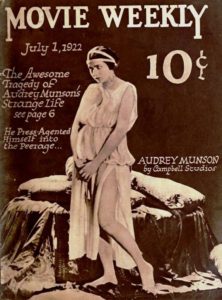Born in Rochester, NY, on June 8, 1891, her parents divorced when she was eight, and the girl and her mother moved to Providence, RI, where they lived until 1909, when they moved to NYC for her to pursue a career on the Broadway stage.
While window shopping on Fifth Avenue, she was approached by a photographer who asked her to pose for him at his studio. He introduced her to his friends in the art world, and she began to pose for numerous artists. Sculptor Isidore Honti persuaded her to do so in the nude, using her as his model for the figures of his Three Graces, commissioned for the Grand Ballroom at the Hotel Astor in Times Square.
 For the next decade, she modeled for a host of sculptures and paintings in New York. By 1915 she was so well established that she became the model of choice for the Panama-Pacific International Exposition, and she posed for nearly half of the sculptures created for the event. She was also the model for the recently renovated Spirit of Life statue in Saratoga Springs, NY, and Walking Liberty engraved on the half-dollar coin. Her profile is on the mercury dime.
For the next decade, she modeled for a host of sculptures and paintings in New York. By 1915 she was so well established that she became the model of choice for the Panama-Pacific International Exposition, and she posed for nearly half of the sculptures created for the event. She was also the model for the recently renovated Spirit of Life statue in Saratoga Springs, NY, and Walking Liberty engraved on the half-dollar coin. Her profile is on the mercury dime.
 Celebrity helped launch her career in the nascent film industry. Portraying a sculptor’s model, she was the first woman to pose entirely nude in an American motion picture. The studio hired a lookalike to do the acting scenes. She subsequently made three other silent films, but only one survived. It was discovered in 1993 in a pornography collection in France.
Celebrity helped launch her career in the nascent film industry. Portraying a sculptor’s model, she was the first woman to pose entirely nude in an American motion picture. The studio hired a lookalike to do the acting scenes. She subsequently made three other silent films, but only one survived. It was discovered in 1993 in a pornography collection in France.
She returned to the East Coast, became involved with high society in NY and Newport and is rumored to have had an affair with “Comstock Lode” silver heir Hermann Oelrichs, Jr., the richest bachelor in America at that time. When that relationship ended she wrote a rambling and scathing letter to the US State Department denouncing Oelrichs as part of a pro-German network that had driven her out of the movie business. Her popularity took a nose dive.
Impoverished, she and her mother were living in a boarding house in Manhattan owned by Dr. Walter Wilkins who fell in love with the young beauty and murdered his wife so he could marry her. During the ensuing scandal, the women fled the spotlight. After a nationwide hunt they were located in Toronto, Canada, where she strongly denied any romantic relationship with the doctor. After extensive questioning she was found innocent of involvement in the crime. Wilkins was tried, found guilty and sentenced to be executed, but he hanged himself in his prison cell before the sentence could be carried out.
Unable to find work anywhere, she and her mother settled in Syracuse, NY, and supported themselves by selling kitchen utensils door to door. In 1933, she unsuccessfully attempted suicide by swallowing a solution of mercury dichloride. Her mother petitioned to have her committed to a “lunatic asylum,” and the Oswego County judge ordered that she be admitted into a psychiatric facility for treatment of depression and schizophrenia. She was thirty-nine years old.
She remained in the St. Lawrence State Hospital for the Insane in Ogdensburg for 65 years. For decades she had no visitors at all, but was rediscovered by family in 1984, when she was 93. To her newfound relatives she seemed lucid and cordial and was still concerned about her appearance. She had lost her teeth, but had shoulder length silver gray hair that was attractively styled, and she was well groomed and dressed. Attendants at the facility said she was a pleasant patient and called her their “resident celebrity.”
Her visitors returned several times over the next ten years and each time brought her chocolate mints which she enjoyed. They did not question her about her past but only talked about family memories and the present. She seemed to understand the relationship and though not terribly talkative, participated appropriately in the conversation.
She died in February, 1996, at the age of 104 and was buried without a grave marker in the family plot in New Haven, NY. In 2016, twenty years after her death, her family added a simple tombstone in commemoration of what would have been her 125th birthday.
Audrey Marie Munson lived her life in anonymity, obscurity and isolation; but in recent years there has been a resurgent interest in her identity. Several books were written about her, and there is information available online, including a documentary showing her many appearances in and around NYC, but I got the story from the half-niece who initiated the family reunion in 1984 and, before it was too late, let her know that she was loved and would always be remembered.
Pediment above the Frick, courtesy of Smithsonian American Art Museum
Might make a great movie
What an interesting story. Who knew.